Have you winterized your outdoor power equipment? Taking a few simple steps before storing your gas-powered tools for the winter will ensure a hassle-free start next spring. It will also extend the life of your small gasoline engines.
Your outdoor power equipment will last for many years with some basic maintenance and care. As you get your equipment ready for storage, it is also a good time to take a few extra preventive maintenance steps. But whatever your plans – full tune-up or just washing the dirt off – remember…
What we cover
ToggleThe most important step is draining or stabilizing the fuel.
Gasoline left in fuel tanks over the winter will degrade leaving gum deposits and varnish build-up that will plug up the fuel system. You can either drain the fuel system or use a fuel stabilizer. I recommend using a stabilizer in your mower and draining fuel from tools with two-cycle engines – string trimmers, blowers, hedge trimmers and chain saws.
Fuel stabilizers will keep the gas fresh until spring. They can be found at most hardware and home stores. After adding the stabilizer, run the engine for at least 5 minutes to be sure the stabilizer gets into the carburetor.
To drain the fuel system, first pour the gasoline out of the tank into a gas can. Then pump the primer bubble several times, start the engine and let it run until the remaining fuel in the carburetor and lines is used up.
Let’s start with mowers and then we’ll discuss the two-cycle engines.
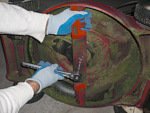
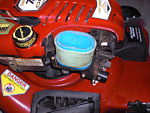
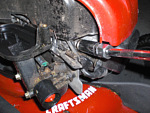
Winterize your lawn mower (4-cycle engines)
Step 1 – Add a fuel stabilizer: Add a fuel stabilizer to a full gas tank and run the engine for a few minutes. Then fill up the tank. A full tank prevents water condensation from getting in the tank and keeps gaskets from drying.
Step 2 – Blades: Remove and sharpen the blade.
Step 3 – Clean the mower deck: The caked-on grass clippings and soil trap moisture next to the metal and cause rust. Tip the mower toward the side with the oil opening, so the oil doesn’t drain into the air filter and carburetor. Scrape with a brush and putty knife, then rinse with water.
Step 4 – Change the engine oil: Old oil contains moisture and acids that will pit bearings and other engine parts, so it’s important to change the oil before storage.
Step 5 – Remove the spark plug: Then pour about a half ounce of oil into the spark plug port. Replace with a new spark plug.
Step 6 – Inspect and clean the air filter: Tap out debris and use compressed air to clean paper filters. Foam filters can be cleaned with soap and water. Replace damaged and extremely dirty filters.
Step 7 – Check the fuel lines and replace the fuel filter: Rubber fuel lines will rot, crack and eventually disintegrate over time.
Step 8 – Inspect for worn or missing parts and hardware: And lube throttle cables, hinges and moving parts.
I use Fluid Film on mower decks to keep grass from building up — the film stays on and dirt and grass won’t stick! It will also protect your outdoor power equipment from rust.
Sta-Bil is my preferred fuel stabilizer. Protects engine from gum, varnish rust, and corrosion
Winterizing your weed eater (2-cycle engines)
String trimmers, blowers, hedge trimmers and chainsaws are usually powered by two-cycle engines. These are really easy to winterize. The most important step is draining the fuel system!
Winterize in Five Easy Steps:
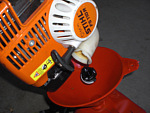
Step 1 – Drain the fuel tank: Press the primer bulb several times. Then try to start the engine and run the rest of the fuel out of the carburetor.
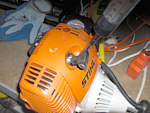
Step 2 – Remove the spark plug: Pour a few drops of two-cycle oil into the spark plug port and give the starter cord a couple of easy pulls. This lubricates the pistons and crankshaft. Install a new spark plug.
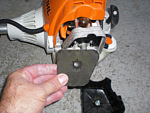
Step 1 – Air filter: Clean and inspect the air filter.
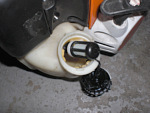
Step 4 – Check fuel lines and replace the fuel filter: Rubber fuel lines will rot, crack and eventually disintegrate over time.
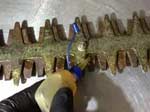
Step 5 – Clean and lubricate moving parts: (e.g. hedge trimmer blades)
Come springtime your clean, gunk-free tools will be ready to mow, trim, rototill and blow!
Tips:
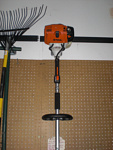
- Store your lawn equipment indoors if possible. Protect them with a tarp if you need to store them outside.
- Use your leftover gas in your car. Unless you treat the gas in your cans with fuel stabilizer, Empty it into your car…or your daughter’s car. She’s probably running around on empty.
- Check on your lawn equipment while it’s stored. Mice and other vermin love to chew on wires and will nest in your machines.
- To dispose old oil properly, take it to a local service station or recycling center. My local Walmart recycles used oil for free.

